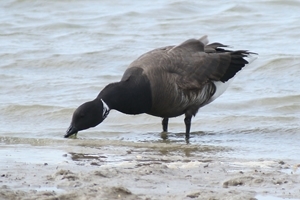Brent goose
 Late autumn heralds the arrival of many species of wintering birds to UK shores, including our smallest migratory goose, the brent goose (Branta bernicla).
Late autumn heralds the arrival of many species of wintering birds to UK shores, including our smallest migratory goose, the brent goose (Branta bernicla).
Some 100,000 brents will spend the milder winter here. Weighing little more than a bag of sugar and no bigger than a mallard, they can be spotted on saltmarshes, rocky coastlines, sheltered bays and beaches between now and February. Unlike many other resident or migratory geese, they don’t tend to range inland very far and prefer to stay on the coast.
You can’t deny this is an attractive goose, with a sleek black head and neck that transitions crisply halfway down its breast to charred grey markings. The feathers have the appearance of burned wood, and indeed this is where the name comes from – in Old Norse word ‘brandgás’ means ‘burnt goose’. The underside of the tail is white and the belly feathers vary in shades of grey depending on which subspecies it belongs to. At the top of the neck it has a white bow-tie marking, which puts the finishing touch on a very smart-looking fowl.
Brent geese form strong bonds and are highly social, living in a co-operative unit of constant observation, feedback and signals. Sometimes you might spot the ‘compass’ geese, which often lead the flock on foot between foraging areas. They are one of the subtler communicators in the world of geese, and their mutterings are usually gentle and easy on the ear.
The diet of brent geese in Britain and Ireland is mostly eelgrass, which grows on sandy seafloors and mudflats. Eelgrass is a rich foraging habitat and nursery for many types of fish and marine animals, and extensive beds are sometimes designated as a protected zone with restrictions on anchorage and fishing. Brent geese are frequently observed skirmishing with each other (and with bigger fowl too) to defend the choicest beds of protein-rich eelgrass rhizomes. The brent goose population seems to be rather tied in fortunes to the health of eelgrass – for example, their numbers crashed below 10,000 in the 1930s when eelgrass was affected by a wasting disease across North America and Europe.
If their favourite food is in short supply, they will also eat sea lettuce, brackish water plants, mosses, algae, grass and lichens. In recent years, brent geese have been increasingly observed on arable land a short distance inland, feeding on winter-sown cereals, and this has earned them a bit of a reputation as a pest in some localities. It is thought this may be in response to variations or decline in eelgrass, but others think that they are simply copycatting other geese.
Despite being the ‘small guys’ amongst their goose-kin, they are quite unflappable, and are rarely intimidated by scarer guns placed in fields to protect young crops. Indeed, a birdwatcher from Dublin who has observed his local brents for decades describes them in his blog, A City, A Goose, as quite spirited and plucky creatures: “they cross all barriers; trespassing at will, classless, independent, a memento to the feckless and flightless humans on the ground.”
Depending on where you are in the country, the brent geese you see might have come from several geographically different breeding grounds in the northern hemisphere. The pale-bellied subspecies, which tends to winter in Jersey, Ireland and Northumberland, has come from Svalbard and Greenland; whereas the dark-bellied geese you see in Norfolk, Essex and the Solent are most likely from Russia.
Contrary to what the medieval folk believed, brent and barnacle geese are not borne of goose barnacles underwater in the sea – I could be mean, but at least people had time for musing and imagination back then. Brent goslings enter the world thousands of miles away on coastal tundra. The adult pair nests in a loose colony on elevated ground, often choosing sites near water where they can easily feed or escape from predators. The nest is built in a bowl shape, sometimes in the lee of a sheltering log, and lined with dried grass and feather down. Here the goose lays between three and five chalky white eggs, and she incubates them for around 25 days whilst the gander guards the territory. Chicks fledge six weeks later, before feeding hungrily and exercising their wings for the long journey ahead.
If food availability is good and youngsters reach migration condition promptly, the brent geese can arrive on European shores early, though it’s unusual to see them before September. Numbers on our coasts usually reach a peak in late October and early November, depending on any delays and challenges they have faced en route.
If you’re lucky enough to live in an area that they frequent in winter, do take a moment to appreciate these fine birds before they leave again next February: our smallest, smartest and arguably sassiest geese!
Jess Brooks
Advisory
Photo credit: Donald Hobern